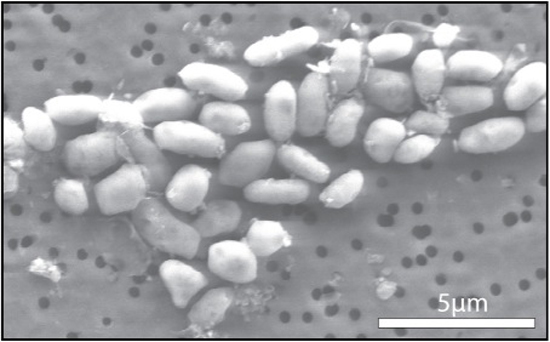
by Damon Martin
Remember the name GFAJ-1 because it may be the organism that changes how we perceive and define life on Earth and eventually in space.
Today, NASA held a press conference announcing the findings of a team led by Felisa Wolfe-Simon, an astrobiologist at the U.S. Geological Survey. The researchers discovered a bacteria originally found at Mono Lake, CA that is able to sustain, grow and reproduce using the element arsenic.

The reason for the scientists’ excitement is because up until now we thought all life was based on the building block elements of carbon, hydrogen, nitrogen, oxygen, phosphorus, and sulfur. In cells, phosphorus is considered essential for life. Arsenic on the other hand has always been considered poisonous. Its make-up is similar that of phosphorus, but it was thought to be universally toxic when it takes the place of the element in biomolecules.
However, researchers took bacteria discovered at the arsenic-laden Mono Lake and experimented by replacing their phosphorus rich diet with an arsenic rich one instead. Over time, they eventually replaced phosphorus completely with arsenic, and the cells continued to grow and reproduce. This finding could potentially change the way scientists view chemistry and life forever.
“The definition of life has just expanded,” said Ed Weiler, NASA’s associate administrator for the Science Mission Directorate. “As we pursue our efforts to seek signs of life in the solar system, we have to think more broadly, more diversely and consider life as we do not know it.”
Four years ago, Wolfe-Simon had proposed that some organisms may be able to survive or even thrive off of an arsenic rich diet, and now she has proven her theory. Along with several other scientists, Wolfe-Simon used mass spectroscopy, radioactive labeling, and X-ray fluorescence to prove and confirm that the bacteria was indeed using arsenic at the biomolecular level instead of phosphorus to grow and reproduce.
Scientists had previously seen microorganisms breathe arsenic, but this is the first discovery of an organism that can actually reproduce using the chemical. The findings could lead scientists down entirely new avenues never before explored as to how life can be created and sustained on this planet and others throughout the universe.
“We know that some microbes can breathe arsenic, but what we’ve found is a microbe doing something new. Building parts of itself out of arsenic,” said Wolfe-Simon. “If something here on Earth can do something so unexpected, what else can life do that we haven’t seen yet?”
Of course there are scientists that are skeptical about the newly discovered. Some scientists argue that while in the lab a microorganism may be able to survive with little phosphorus, the complete replacement of the element with arsenic is still under question. They’ve also brought up the issue of the survivability of the bacteria outside of the controlled conditions of the science lab.
Still, the discovery was intriguing enough to prompt NASA to hold a much-anticipated press conference this morning. And the government body stands behind Wolfe-Simon and her team. Indeed, science may have just been turned on its theoretical head.
“If this result is true, we’ve got to go back and rewrite a lot of chemistry,” said Steven Brenner, an astrobiologist at the Foundation for Applied Molecular Evolution.
NASA believes the findings announced today could be crucial in future scientific exploration into how Earth evolved, biochemistry, organic chemistry and yes, even life on other planets.

